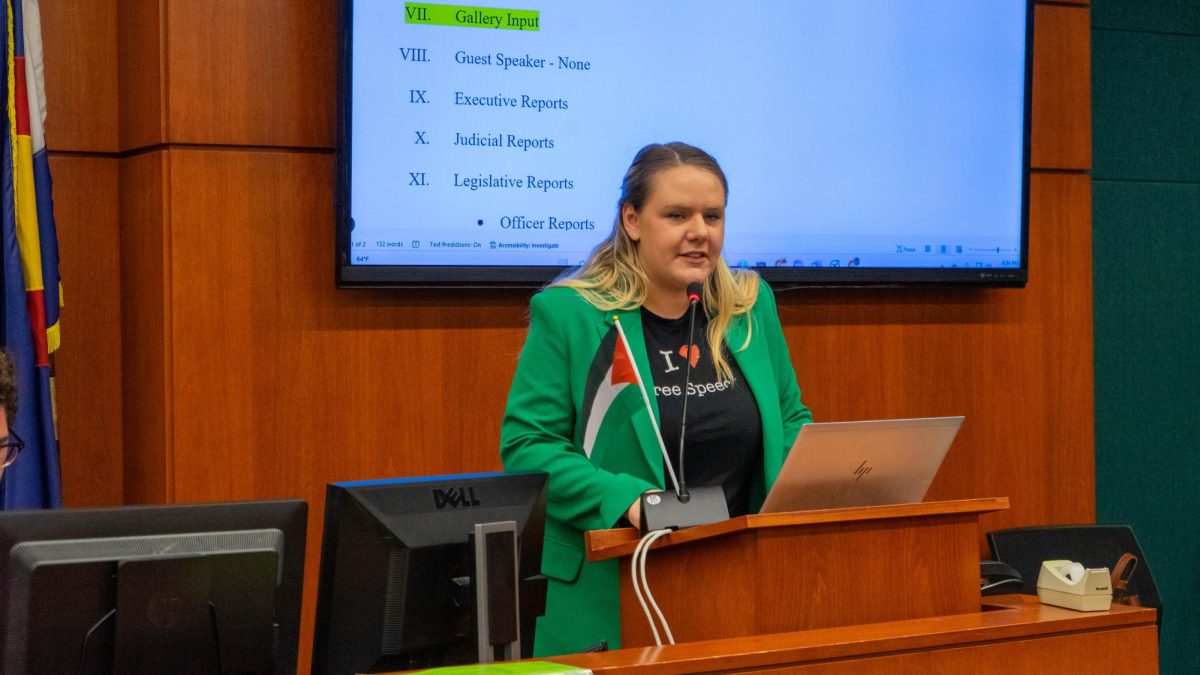Editor’s note: The following interviews were conducted before the 2012-2013 Winter Break.
In 2003, CSU’s minority students represented 11.4 percent of the student body. By fall 2012, that number increased to 15.6 percent. The uptick in underrepresented persons’ enrollment at CSU is good for the university, but there is still room for improvement, according to Mary Ontiveros, CSU vice president for diversity.
“We are more diverse than we’ve ever been,” Ontiveros said. “Are we as diverse as perhaps we should be? Probably not. It would be nice to have more of that kind of diversity on campus.”
With the help of campus officials, the Collegian analyzed the enrollment of racially and ethnically diverse students in each of CSU’s eight colleges and intra-university program.
In 2003, 15.8 percent of students in the College of Veterinary Medicine and Biomedical Sciences were minorities, making it the most diverse at the time. The least diverse was the Warner College of Natural Resources, whose student body was 6.8 percent minority.
The College of Natural Sciences is currently the most diverse on campus. About 19.4 percent of its students are minorities. The Warner College of Natural Resources continues to be the least diverse at CSU, as it has been for seven of the past nine years. In 2012, just 9.5 percent of its students are minorities.
College of Agricultural Sciences
2003: 7.2 percent were minorities
2012: 11 percent were minorities
Nine-year change: 3.9 percent increase
Diversity in the College of Agricultural Sciences is gradually increasing and is following CSU’s diversity mission plan to grow the college’s minority population, according to Nancy Irlbeck, associate dean of academic affairs. The college hired a recruiter, Ruben Flores, who helps provide infrastructure for the college and increase both recruitment and retention.
Irlbeck predicted that the Hispanic population within Colorado will be predominant within a few years. She believes the College of Agricultural Sciences needs to change Latinos’ perspective on agriculture and encourage involvement.
“Our role within the College of Agricultural Sciences is to help change the perception that these young men and these young women have of agriculture, and that you don’t have to be a migrant worker, you don’t have to work in a packing plant, you can work as a leader,” Irlbeck said.
College of Applied Human Sciences
2003: 11.4 percent were minorities
2012: 17 percent were minorities
Nine-year change: 5.6 percent increase
A “number of units” have been created to help diversify the College of Applied Human Sciences (CAHS), particularly when it comes to retention, recruitment and inclusion, according to Malcolm Scott, co-chair of the college’s Diversity Committee.
Scott said CAHS has maintained an active diversity committee and has also partnered with historically black colleges and universities.
CAHS is also spearheading efforts to bring the Vice President of Diversity from Texas A&M University to CSU for a consultation and presentation, according to Scott.
College of Business
2003: 10.2 percent were minorities
2012: 13.3 percent were minorities
Nine-year change: 2.1 percent increase
Mike Jaramillo, director of undergraduate programs for the College of Business (COB), said that some ways the school has worked to increase diversity include improving resources for diverse students, improving inclusivity and educating faculty and staff on diversity issues.
“We have made it easier for us to retain diverse students,” Jaramillo said.
Jaramillo said the college also has several diversity-related organizations such as the Business Diversity and Leadership Alliance, which is centered on including of all types of diverse students, from gender to sexual orientation, ability, class, religion, race and ethnicity.
In addition, the College of Business Mentoring Program pairs first generation and ethnically diverse students with a junior or senior in the college.
“The more diverse a class is, the more perspectives, the more ideas –– the more students learn,” Jaramillo said.
College of Engineering
2003: 8.9 percent were minorities
2012: 11.6 percent were minorities
Nine-year change: 2.7 percent increase
According to Kathleen Baumgardner, director of the College of Engineering, the college has run a student ambassador program in the last six years. The plan of action pairs current students with prospective students to determine if their programs fit their needs.
“It is our belief that this program is particularly helpful for not only women but also ethnically diverse groups,” Baumgardner wrote in an email to the Collegian.
According to Baumgardner, since 2007 the percentage of undergraduate ethnically diverse students has increased at a rate of 57.6 percent, compared with the total undergraduate enrollment which has increased at a rate of 39.9 percent.
“Living and learning among students from various ethnic, cultural, geographic, socioeconomic, linguistic and religious backgrounds benefits every student and the college as a whole,” Baumgardner said.
Intra-University (undeclared student advising)
2003: 14.2 percent
2012: 21.3 percent
Nine-year change: 8.1 percent
Intra-University is the name given to undeclared student advising, which is housed under CSU’s Center for Advising and Student Achievement (CASA). With 21.3 percent of its students coming from underrepresented backgrounds, it is the most diverse part of CSU’s campus.
According to Madyln D’Andrea, director of advising for undeclared students, minorities enrolled at CSU are attracted to key communities, which target diverse students when they apply for admission. The programs require students to live (often in Braiden Hall) and take classes together, creating a built-in support group to encourage retention.
“Our newest community is Key Explore: that’s for students who want to see their other options before they take a major choice,” D’Andrea said. Of these students, 50 percent them are ethnically and racially diverse.
The reasons for being an undeclared student, according to D’Andrea, come from wanting to explore majors before declaring, not knowing the different majors available as well as not yet meeting the requirements for competitive majors such as engineering or business.
“I think we’re doing more than a lot of universities and institutions and we’re all really proud of that,” D’Andrea said. “The students are just wonderful to work with because they are so interested and eager to be here.
College of Liberal Arts
2003: 13.1 percent were minorities
2012: 18.1 percent were minorities
Nine-year change: 5 percent increase
The number of diverse students in the College of Liberal Arts is increasing because of changes in admissions, according to Associate Dean Irene Vernon. The faculty diversity, however, is “dreadful,” she said.
In 2003, 10 percent of the university’s teaching staff came were minorities. In 2012, that number climbed to 14 percent.
When looking at the numbers, it appears that CSU is doing well with underrepresented faculty members, with a very high percentage of Asians, according to Vernon.
Out of the 146 minority teachers on campus, 75 are Asian. There are 10 Asian faculty members in the College of Liberal Arts, which has 30 minority faculty members in total.
“The school needs to develop, create and support both resources and financial ways to come up with a plan,” she said. “There has to be a strong group and committee in both to recruit and retain and I don’t think we’re doing that, if anybody is heading something like that.”
Vernon said she believes that diversity cannot be looked at as a compartmentalized situation but a topic that needs to be at the root and core of the university.
“All we have to do is think about what the future is going to look like in America and how the demographics are changing,” she said. “It’s not looking into the future anymore. It’s now.”
College of Natural Sciences
2003: 14 percent were minorities
2012: 19.4 percent were minorities
Nine-year change: 5.4 percent increase
The College of Natural Sciences has a history of diverse undergraduate students. The college is almost 4 percent above the total percentage of minority students at CSU and first in the number of diverse students as a science college, according to Dean Janice Nerger.
The college has a variety of programs that help recruit and retain diverse students, according to Nerger. It has a leadership role in the consortium for the Colorado Louis Stokes Alliance for Minority Participation, which works to increase the recruitment, retention and graduation of underrepresented students who earn bachelor’s degrees in science, technology, engineering or mathematics.
Additionally, the college has organizations and clubs that connect students with those of similar interests. The CSU chapter of the Society for the Advancement of Chicanos and Native Americans in Science (SACNAS) promotes and supports recruitment and retention of underrepresented minorities, and was recognized for seven consecutive years at the SACNAS National Conference for its work with diverse students, according to Nerger.
College of Veterinary Medicine and Biomedical Sciences
2003: 15.8 percent were minorities
2012: 16.9 percent were minorities
Nine-year change: 1.1 percent increase
Over the last four years, underrepresented student enrollment for the college remained stable, according to Kenneth Blehm, associate dean of CVMBS. Each year has had some fluctuation, which is likely caused by differences in the number of people reporting their minority status and changes in federal classification of underrepresented students.
“Overall we continue to attract minority students who share a passion for applied life sciences in an environment that stresses integrated hands-on learning to complement rigorous classroom programs,” Blehm wrote in an email to the Collegian.
The college has attempted to focus its publicity efforts on attracting minority students through university initiatives. Students who enroll in CVMBS learn to explain complex topics, solve problems, learn actively and communicate clearly. Relative to these attributes, there is no difference between minority and non-minority students, said Blehm.
Warner College of Natural Resources
2003: 6.8 percent were minorities
2012: 9.5 percent were minorities
Nine-year change: 2.7 percent increase
The Warner College of Natural Resources (WCNR) is the least diverse college on campus, but the numbers of ethnic and diverse students are increasing.
“I think it’s pretty easy to go from, when your numbers are pretty low to increase those numbers,” said Ethan Billingsley, assistant director of undergraduate programs at WCNR. “Historically, we haven’t been extremely diverse.”
Billingsley believes that this is partially reflective of the population of Colorado
“Our population has changed dramatically in the last 30 years, looking at racial diversity, there’s been a large upswing in the Latino population,” he said. “We’re seeing more of these students as well.”
In Larimer County, according to Billingsley, the Latino population is 25 percent of the total population.
“When the U.S. forest services wants to talk about how we manage the land here in Larimer County, we need to understand how the entire population wants to use the land. It’s everybody’s land,” Billingsley said. “Not just the 75 percent.”
Fields of study like wildlife, forestry and geology have not always been linked in the school-setting to allow diverse students to be introduced to these areas of studies.
Billingsley used African American communities concentrated in urban centers as an example.
“They didn’t have a connection already with natural resources so that didn’t lead them to study it,” Billingsley said. “Those barriers are coming down as more work is down to include all people in understanding natural resources.”
Billingsley said the attraction for students to WCNR is generally, “I have a passion for the outdoors, I like the outdoors, I want to study things that have to do with the outdoors.”
For those who love the outdoors, WCNR has provided more outlets to recruit more students, such as a club on campus called Minorities in Natural Resources, Agriculture and Related Sciences, for which Billingsley is the advisor.
“The goal of this organization is to assist in student success and professional development of diverse students in these fields,” he said.
Senior Reporter Kate Winkle, Student Life Beat Reporter Bailey Constas and News Editor Emily Smith can be reached at news@collegian.com.




